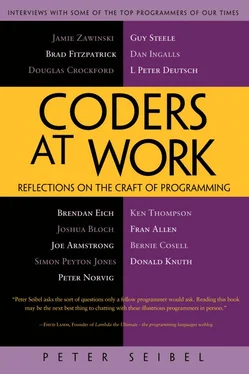Peter Seibel - Coders at Work - Reflections on the craft of programming
Здесь есть возможность читать онлайн «Peter Seibel - Coders at Work - Reflections on the craft of programming» весь текст электронной книги совершенно бесплатно (целиком полную версию без сокращений). В некоторых случаях можно слушать аудио, скачать через торрент в формате fb2 и присутствует краткое содержание. Жанр: Программирование, на английском языке. Описание произведения, (предисловие) а так же отзывы посетителей доступны на портале библиотеки ЛибКат.
- Название:Coders at Work: Reflections on the craft of programming
- Автор:
- Жанр:
- Год:неизвестен
- ISBN:нет данных
- Рейтинг книги:3 / 5. Голосов: 1
-
Избранное:Добавить в избранное
- Отзывы:
-
Ваша оценка:
- 60
- 1
- 2
- 3
- 4
- 5
Coders at Work: Reflections on the craft of programming: краткое содержание, описание и аннотация
Предлагаем к чтению аннотацию, описание, краткое содержание или предисловие (зависит от того, что написал сам автор книги «Coders at Work: Reflections on the craft of programming»). Если вы не нашли необходимую информацию о книге — напишите в комментариях, мы постараемся отыскать её.
Coders at Work
Founders at Work
Coders at Work: Reflections on the craft of programming — читать онлайн бесплатно полную книгу (весь текст) целиком
Ниже представлен текст книги, разбитый по страницам. Система сохранения места последней прочитанной страницы, позволяет с удобством читать онлайн бесплатно книгу «Coders at Work: Reflections on the craft of programming», без необходимости каждый раз заново искать на чём Вы остановились. Поставьте закладку, и сможете в любой момент перейти на страницу, на которой закончили чтение.
Интервал:
Закладка:
Norman Ramsey at Harvard found a way to use this for walking around data structures that represent imperative control flow graphs. So he and I and John Dias then spent a while reengineering GHC’s back end to adopt essentially this factored technology. And in doing so making it much more general so we can now use this same back end as a back end for other languages.
A lot of our discussion was essentially at the type level. Norman would say, “Here’s the API,”—by giving a type signature—and I would say, “That looks way complicated, why is it like that?” And he’d explain why and I’d say, “Couldn’t it be simpler this way.” So we spent a lot of time to’ing and fro’ing at the level of describing types.
But a lot of the time it wasn’t really about programming as such—it was about, what is the idea? What are we trying to do with this dataflow analysis, anyway? You try to say in a clear way what this step of the program is meant to do. So we spent quite a lot of time just being clear on what the inputs and the outputs are and working on the data types of the inputs and the outputs. Just getting the data types right, already you’ve said quite a lot about what your program does. A surprisingly large amount, in fact.
Seibel:How does thinking about the types relate to actually sitting down and coding? Once you sketch out the types can you sit down and write the code? Or does the act of writing the code feed back into your understanding of the types?
Peyton Jones:Oh, more the latter, yes. I’ll start writing type signatures into a file right away. Actually I’ll probably start writing some code that manipulates values of those types. Then I’ll go back and change the data types. It’s not a two-stage process where we say, “Now I’ve done the types, I can write the code.”
If anything I’m a bit ill-disciplined about this. This comes from not working as part of a large team. You can do things when you’re working on code that one person can still get their head around that you probably couldn’t in a much bigger team.
Seibel:You mentioned that in this latest code upheaval in GHC, things got much more general. GHC is a big program that’s evolved over time so you’ve had the chance to benefit from generality and the chance to pay the cost of over-generality. Have you learned anything about how to strike the balance between over- and under- generalization?
Peyton Jones:I think my default is not to write something very general to begin with. So I try to make my programs as beautiful as I can but not necessarily as general as I can. There’s a difference. I try to write code that will do the task at hand in a way that’s as clear and perspicuous as I can make it. Only when I’ve found myself writing essentially the same code more than once, then I’ll think, “Oh, let’s just do it once, passing some extra arguments to parameterize it over the bits that are different between the two.”
Seibel:What is your actual programming environment? What tools do you use?
Peyton Jones:Oh, terribly primitive. I just sit there with Emacs and compile with GHC. That’s just about it. There are profiling tools that come with our compiler and people often use those for profiling Haskell programs. And we do that for profiling the compiler itself. GHC dumps a lot of intermediate output so I can see what’s going on.
Debugging, for me, is often, the compiler isn’t generating good code so I’m eyeballing the state of its entrails. Or, take this little source program; compile it this far; look at that. That’s debugging for me. It’s seldom singlestepping through the program—it’s more looking at values of different parts in compilation.
I don’t even have any very sophisticated Emacs jiggery-pokery. Which some people do. There’s also a whole world of people out there who are used to Visual Studio and Eclipse kind of IDEs. I think a cultural barrier to adoption of functional programming languages is partly that we haven’t got the IDE story sorted out. There’s a bit of a chicken-and-egg problem here. At the moment the chicken is getting busier—there’s more interest in functional programming generally. I’m hoping that will provoke work on the egg. It’s a lot of engineering to build an IDE for Haskell. Even with Visual Studio as a shell or Eclipse as a shell, there’s quite a lot of work in making a plugin that’s really smooth and does everything right.
Seibel:GHC has a read-eval-print loop, GHCI. Do you tend program Haskell interactively?
Peyton Jones:Actually, I tend to mostly edit and compile. But other people just live their whole lives in GHCI.
Seibel:When it comes to testing, I suppose one of the nice things about functional languages is when you want to test some little function in the bowels of your program, you just have to figure out what form is its input going to be.
Peyton Jones:Well, for me, if the input data is simple enough that you could do that, it’s probably not going to be the problem with my program. The problem with my program is going to be some fairly humongous input program that GHC is trying to compile and getting the wrong answer for it.
Testing is, I think, frightfully important for writing down properties and QuickCheck properties are really useful—QuickCheck is a Haskell library for generating random tests for a function based on its type. But I was trying to think why I don’t use QuickCheck—which is a very nice tool—more. I think it’s because the situations that cause me trouble are ones that I would find it difficult to generate test data for. In any case, there are loads of people out there generating programs that make GHC barf in one way or another. That’s what GHC’s bug tracker is about.
So typically I’m starting with something that’s not right, already. Maybe the compiler could just fall over altogether or reject a program when it shouldn’t. Or it could just generate suboptimal code. If it’s just generating bad code, I’ll look at the code at various stages in the compilation pipeline and say, “It looks good then; it looks good then. Bah, it’s gone bad here; what’s gone wrong?”
Seibel:So how do you actually look at it?
Peyton Jones:GHC has flags that let you say, in rather a batch-dumpy kind of way, “Just print out various things.”
Seibel:Built-in print statement debugging?
Peyton Jones:Yes. And it’s aided by the fact that the structure is like most compilers: it has this top-level structure of a pipeline of things that happen. If something’s gone wrong in the middle of one of these passes, then that could be a bit trickier. But I tend to use rather unsophisticated debugging techniques. Just show me the program before and after this pass. Aaah, I see what’s going wrong. Or sometimes I don’t see what’s going wrong so then I might scatter a few unsafe printfs around to show me what’s actually going on.
There are various debugging environments for Haskell—a summer student, Pepe Iborra, did a nice one earlier this year which now comes with GHC, which is an interactive debugger of some kind. Which I’ve not used very much yet. Partly because we haven’t had one for so long, because it’s less obvious how do you single-step a functional program.
It’s been a kind of interesting research question of how you go about debugging functional programs for some time. It’s a bit embarrassing that we can’t tick that box in a straightforward way, but that makes it an interesting research problem.
That was the long way around of saying that I tend to use terribly crude debugging techniques with unsafe printfs. And I’m not very proud of that. But for a long time we didn’t have anything else. At least as far as GHC is concerned, I’ve evolved mechanisms that mean that’s the shortest path to completion for me.
Читать дальшеИнтервал:
Закладка:
Похожие книги на «Coders at Work: Reflections on the craft of programming»
Представляем Вашему вниманию похожие книги на «Coders at Work: Reflections on the craft of programming» списком для выбора. Мы отобрали схожую по названию и смыслу литературу в надежде предоставить читателям больше вариантов отыскать новые, интересные, ещё непрочитанные произведения.
Обсуждение, отзывы о книге «Coders at Work: Reflections on the craft of programming» и просто собственные мнения читателей. Оставьте ваши комментарии, напишите, что Вы думаете о произведении, его смысле или главных героях. Укажите что конкретно понравилось, а что нет, и почему Вы так считаете.












